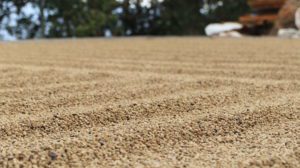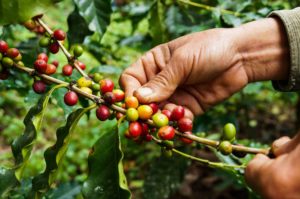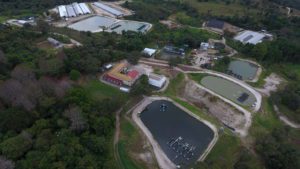In another post, Arabica and Robusta – A Gourmet’s Guide we discussed some of the key differences between Arabica and Robusta coffee beans. If you drink gourmet coffee, then you’ve encountered terms like 100 percent Arabica, and you know that this one species of coffee plant accounts for virtually all of the specialty roasts you enjoy. Then how is it that one gourmet roast can taste so different from another? An obvious factor is how long beans undergo roasting, but this primarily determines how light or dark the final product is, and doesn’t account for myriad other nuances. One dark roast may be bold, another mild. A light roast might carry fruit notes, or spicy ones. So what is the variable that causes these subtle, and sometimes not-so-subtle, differences in the aroma, taste, and body of a given gourmet coffee? The answer is probably one you’ve heard before: Location, location, location.

The Coffee Belt
Arabica coffee grows best at higher altitudes (between 3,000 and 6,000 feet), in cool to warm subtropical climates (the ideal temperature around 70°F) with plenty of precipitation and sunshine. This set of conditions spans the globe in an approximate band around the equator, extending as far north as Mexico and as far south as Brazil and Papua New Guinea. Experts commonly refer to this zone as the Coffee Belt.
While 70 percent of the world’s cultivated coffee comes from the Arabica plant, its superiority to Robusta for pure drinking means that it accounts for an even larger portion (if not all) of gourmet coffee consumed worldwide. Variations in the final product of Arabica coffee can be attributed to the growing conditions from region to region within the Coffee Belt. Here are some of the distinct flavor profiles associated with the gourmet coffees of a few major regions.
Central America
Coffees of Central America feature well-balanced flavors, a range of body textures, and clean finishes. Flavors include sweet notes of chocolate and citrus. Guatemalan roasts are lighter in body with fruit and floral notes ranging from sweet to tart. Coffees from Colombia, Brazil, and Peru are medium in body and acidity. They have flavors that are earthy, nutty, and spicy. Honduras favors coffees that are light to full bodied, with sweet finishes and notes of fruit and caramel.
Africa
Coffees from Africa are medium to full bodied, brightly acidic, and fruity. Ethiopian coffee carries a clean finish, and spicy flavor. Kenya coffee is zesty and floral, while coffee of Uganda is more herbal, featuring earthier tones such as vanilla.
Asia
The coffees of Asia tend to be heavier in body with medium to low acidity. They feature darker, earthier tones. Coffees from the region of Sumatra and Java range from nutty to chocolatey. In Papua New Guinea, flavors are earthy with notes of dried fruit, and a lingering finish.
The Importance of Geography
 Clearly, regional differences in climate, soil quality, and cultivation have a distinct impact on the flavor of any gourmet coffee. Understanding the geography of coffee cultivation can help a connoisseur to know what to expect from a cup or batch of beans. But there is another aspect of regional fluency that comes into the coffee selection process.
Clearly, regional differences in climate, soil quality, and cultivation have a distinct impact on the flavor of any gourmet coffee. Understanding the geography of coffee cultivation can help a connoisseur to know what to expect from a cup or batch of beans. But there is another aspect of regional fluency that comes into the coffee selection process.
Knowing where your coffee comes from contributes not only to a deeper appreciation of cultivation and flavor, but to a better world market. A strong reputation for gourmet coffee can bolster the industry for a particular region. Gourmet coffee drinkers look for consistency and quality in their cup, and these can be traced directly back to the farm. By virtue of this link, coffee growers have greater accountability for the product they put into the market, and the means by which they produce it. Coffee growers with a reputation for responsibility to their consumers are compelled to be more open about their business practices. Thus a quality product also encourages responsibility to a grower’s workers.
Subida Coffee Company
Subida Coffee Company is a brand owned and operated by Mission UpReach, Inc. a 501.c.3. non-profit organization. Every plant is optimally cared for, and all coffee selectively hand-picked. Subida oversees its own processing facility and inspects its coffee by hand before bagging. This dedication not only serves the quality of the final cup, but creates numerous jobs in the local community.
The coffee itself is grown at the Moses Project, a 120-acre farm outside of Santa Rosa de Copán in Honduras. In addition to the cultivation of coffee, the Project serves as an agricultural training center for young men. Here they learn technical as well as economical best practices for agriculture, with specific attention to coffee, poultry, and fish. Involvement in the Project also stipulates that these young men complete their high school education, ensuring that they become well-rounded members of their communities.

By purchasing Subida Coffee, you are making an investment. This is an investment not only in the excellence of your coffee, but the quality of production—and life—in Honduras. In so many ways, the future of coffee across the globe is one that we share. We owe it to ourselves, and to the world, to support the very best.
To learn more about the mission and products of Subida Coffee, visit our website at: www.subidacoffee.com/about.

